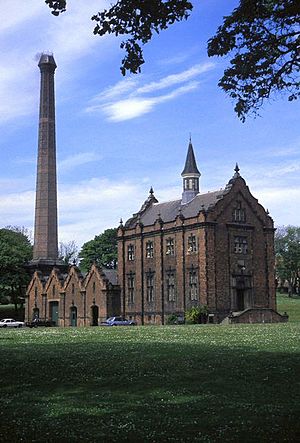Ryhope Engines Museum facts for kids
The Ryhope Engines Museum is a special place in Ryhope, a suburb of Sunderland, England. It's a museum where you can see huge, old steam engines that used to pump water.
This museum is inside a building called The Ryhope Pumping Station. This station worked for 100 years, helping to provide water, before it closed in 1967. The building itself is very old and beautiful, built in a style called Jacobean. It has cool curved gables and a tall, round brick chimney. One historian even called it a "cathedral of pistons and brass" because it's so grand!
The museum is run by volunteers who are part of the Ryhope Engines Trust. They work hard to keep the old machines in great shape. The land and buildings belong to Northumbrian Water, which is the company that took over from the original Sunderland & South Shields Water Company. That company built this whole place back in the 1860s.
The Amazing Engines
The main attractions at the museum are two giant Victorian beam engines. These engines are almost exactly alike and were made by a company called R & W Hawthorn from Newcastle. People say they might be the best pair of their kind in Great Britain!
Each of these huge beams weighs 22 tons, which is like 22 small cars! And each flywheel (a heavy wheel that helps keep the engine running smoothly) weighs 18 tons. You can see both of these incredible engines working and steaming on certain weekends and holidays throughout the year. It's a truly impressive sight to watch them in action.
Other Cool Things to See
Besides the main engines, the museum has many other interesting things to explore.
- There are three large Lancashire boilers from 1908. Two of these are still used regularly to make the steam for the engines.
- You can also see a blacksmith's forge, where metal was heated and shaped.
- There's a waterwheel and many other smaller steam engines and pumps.
- The museum also has a copy of an old plumber's shop, showing what it would have looked like long ago.
- A really cool feature is a special viewing panel in the floor of the engine house. Through this, visitors can look all the way down into the 250-foot deep well shaft!
More Pumping Stations
- Tees Cottage Pumping Station: This is another place in County Durham where you can see old waterworks engines still working.
- Dalton Old Pump House: This is a former pumping station nearby. It also has a pair of old engines, but they don't use steam anymore.


